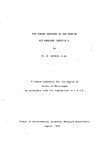THE IMMUNE RESPONSE OF THE DOGFISH SCYLIORHINUS CANICULA L.
| dc.contributor.author | MORROW, W.J.W. | |
| dc.contributor.other | School of Biological and Marine Sciences | en_US |
| dc.date.accessioned | 2013-11-22T13:26:49Z | |
| dc.date.available | 2013-11-22T13:26:49Z | |
| dc.date.issued | 1978 | |
| dc.identifier | NOT AVAILABLE | en_US |
| dc.identifier.uri | http://hdl.handle.net/10026.1/2819 | |
| dc.description.abstract |
A number of aspects of the humoral and cellular immune responses of the common dogfish Scyliorhinus canicula L. were examined in order to define the immunological status of the animal in relation to its phylogenetic origins. The dogfish was shown to have the ability to produce specific antibody in response to a variety of soluble and particulate protein antigens. The existence of several non-specific defence mechanisms was demonstrated including a well established reticulo-endothelial system capable of rapidly clearing injected foreign material from the blood and also the bacteriolytic enzyme, lysozyme. Specific antibody from the fish had marked agglutinating properties which could be destroyed with reducing agents but which could not be demonstrated to form precipitin lines in agar gels. It could also fix complement. Isolation and characterisation of the antibody molecule showed it to have virtually neutral electrophoretic mobility, a molecular weight of approximately 800,000 daltons and a sedimentation coefficient of 18.6S. On reduction the molecule was shown to comprise heavy and light polypeptide chains with molecular weights of 76,000 and 18,000 daltons, respectively. On the basis of these findings the antibody was considered to be of the IgM class of immunoglobulin found in higher vertebrates. This was the only immunoglobulin found in the dogfish although an antigenically identical protein with a molecular weight of 160,000 daltons was also demonstrated and this was considered to be a monomeric form of an IgM pentamer. A survey of lymphoid tissues revealed that the fish had a well developed spleen. This organ was also shown to be directly involved in immunological reactions. Conversely, the thymus was poorly developed and involuted during an early stage in the life of the fish. Its immunological contribution was not determined. Two other tissues, the organ of Leydig and the epigonal tissue were found to comprise a high proportion of poorly differentiated lymphoid cells and these were considered to be similar to the stem cells of the bone marrow found in mammals. Ultrastructural examination of peripheral blood leucocytes showed that they comprised populations of cells analagous, to mammalian lymphocytes, plasma cells, granulocytes, and monocytes. Using a specific antiserum and an immunofluorescence technique, a high proportion of leucocytes were revealed to have immunoglobulin determinants on their surface. In a number of experiments to investigate cellular functions in vitro it was found that dogfish leucocytes could be stimulated by a variety of mitogenic substances but these results were insufficient to provide evidence for lymphocyte heterogeneity. Evidence that the dogfish was capable of weak recognition of histocompatibility antigens was provided in vitro by mixed lymphocyte cultures and in vivo by reaction to injected allogeneic leucocytes. Although several different techniques were used no evidence of immediate hypersensitivity reactions could be demonstrated. Delayed hypersensitivity was shown, however, by the leucocyte migration inhibition test and possibly by local skin reactions. The immunological relationship of the dogfish to an intestinal helminth parasite, Proleptus obtusus, was also investigated. The fish was found to be capable of producing antibody specific for the cuticle of the nematode. The parasite could also invoke several cellular reactions including the stimulation of leucocytes in vitro and delayed but not immediate hypersensitivity. | en_US |
| dc.language.iso | en | en_US |
| dc.publisher | University of Plymouth | en_US |
| dc.title | THE IMMUNE RESPONSE OF THE DOGFISH SCYLIORHINUS CANICULA L. | en_US |
| dc.type | Thesis | |
| plymouth.version | Full version | en_US |
| dc.identifier.doi | http://dx.doi.org/10.24382/3469 | |
| dc.identifier.doi | http://dx.doi.org/10.24382/3469 |
Files in this item
This item appears in the following Collection(s)
-
01 Research Theses Main Collection
Research Theses Main


